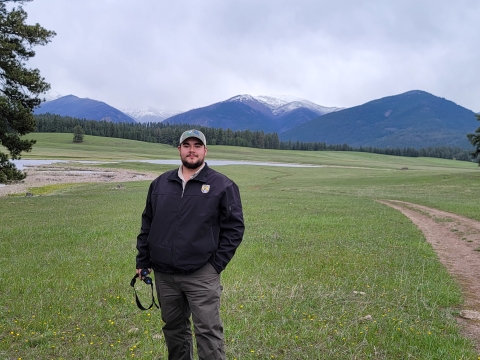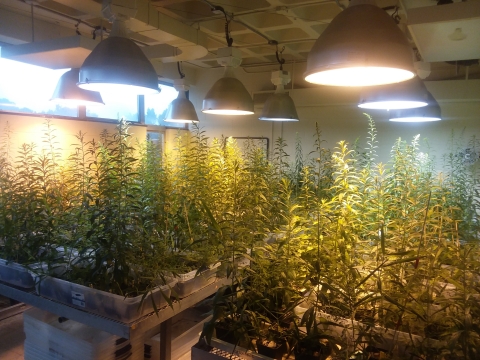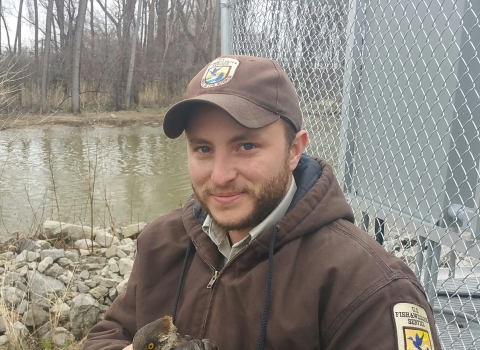Matthew Hodges is passionate about restoring habitat to conserve declining species including freshwater mussels and endemic species of the longleaf pine ecosystem. He is a partners for fish and wildlife biologist who serves as a bridge to ranchers, farmers, Tribal governments, non-governmental organizations, and other private landowners, forming partnerships for collaborative conservation. Through these partnerships, projects are being completed to control and reduce the spread of invasive species invasive species
An invasive species is any plant or animal that has spread or been introduced into a new area where they are, or could, cause harm to the environment, economy, or human, animal, or plant health. Their unwelcome presence can destroy ecosystems and cost millions of dollars.
Learn more about invasive species , restore fire-maintained longleaf pine habitat, widen riparian riparian
Definition of riparian habitat or riparian areas.
Learn more about riparian buffers, remove barriers to fish passage fish passage
Fish passage is the ability of fish or other aquatic species to move freely throughout their life to find food, reproduce, and complete their natural migration cycles. Millions of barriers to fish passage across the country are fragmenting habitat and leading to species declines. The U.S. Fish and Wildlife Service's National Fish Passage Program is working to reconnect watersheds to benefit both wildlife and people.
Learn more about fish passage , and initiate sustainable agricultural practices.
Matthew recently published an article titled, “Investigating the Role of Soil Legacy Effects in the Management of Lespedeza cuneata, an Invasive Legume.” The USFWS Library is celebrating Service scientists who are committed to science excellence and the work of conservation through the FWS Scholar series.
Growing up in eastern North Carolina, Matthew spent many vacations outdoors with his family. It was not uncommon to find him camping in the same campgrounds his parents went to with their parents, paddling around trying to get a good view of wildlife, or hiking trails on nearby public lands. Matthew was very engaged in the Boy Scouts of America from elementary school through college. His journey as a Boy Scout taught him how to be a good steward of natural resources, but most importantly, it instilled in him life lessons on leadership and communication.
After high school, Matthew studied at East Carolina University in North Carolina. He earned a bachelor of science and master of science in biology in addition to a graduate certificate in geographic information science and technology.
For his graduate research, he was advised by Dr. Carol Goodwillie and studied the plant-soil interactions of an invasive legume, and how legacy effects (impacts that previous conditions have on current processes) of those interactions impact the restoration of native plants. When designing the research, Matthew wanted the results to be directly applicable to management. Invasive species present a growing national and international threat to biodiversity.
His research focused on sericea lespedeza (Lespedeza cuneata), which was initially introduced to the United States from Japan in 1896. It was intentionally planted as a means of erosion control and wildlife cover. Use of sericea lespedeza really picked up in the 1930's, and by the 1980's the negative impacts the invasive species was having on the landscape were becoming noticeable. Previous research conducted primarily in the Midwest prairies documented that L. cuneata alters properties of the soil it occupies, creating positive legacy effects to encourage its own growth. As with other legumes, L. cuneata forms nodules along its roots and forms a mutually beneficial relationship with soil bacteria.
For his thesis research, Matthew collected soils along the South Tar Greenway in Greenville, North Carolina. This greenway offered areas without a history of invasion, sites of ongoing invasion, and sites where the invasion was being controlled using herbicide. Through a series of growth room experiments, his study investigated how soil legacy effects created by an invasion of L. cuneata and the use of herbicide impacted the germination and growth of L. cuneata and three native species. In addition, he explored how these legacy effects impacted the seedbank within the soil. A seedbank consists of new seeds recently shed by nearby plants as well as older seeds that have persisted in the soil for several years. The seed bank is an indicator of past and present plant populations.
Results from his study found that a history of invasion did not significantly increase the growth of new plants, size of new plants, or number of root nodules of L. cuneata. However, the research did find that the use of herbicide caused L. cuneata to grow larger and produce significantly more root nodules. In addition, the research showed that the use of herbicide significantly reduced the number of seedlings to emerge from the seedbank. These results indicate the use of herbicide may create areas susceptible to reinvasion by L. cuneata or another exotic species. These results and others from this research were published in the Natural Areas Journal in April of 2023.
While still a student, Matthew was selected for the U.S. Fish and Wildlife Service’s (USFWS) Directorate Fellows Program (DFP). During his fellowship, he worked with various USFWS stations in the Delaware River Basin to better understand common needs and hurdles to conservation efforts to help guide resources and maximize impacts on the landscape.
Currently, Matthew lives in Daphne, Alabama with his wife Alisha and dog Rocket. He is stationed at the Alabama Ecological Services Field Office. In his position, Matthew provides technical assistance to private landowners interested in habitat restoration and wildlife management on their property and offers cost-share opportunities for management activities through the Partners for Fish and Wildlife Program.
In south Alabama, focal areas of the Partners program exist for both longleaf pine restoration and aquatic freshwater habitat. Projects restoring fire-maintained longleaf pine ecosystem are done primarily for the benefit of gopher tortoise and its associate species. Over 360 species have been documented living in active or abandoned gopher tortoise burrows, making these reptiles a keystone species on the landscape. Of these many associate species, many are also declining in population including eastern indigo snakes and dusky gopher frogs. These projects include the planting of longleaf pine, implementation of an appropriate fire regime, and control of exotic vegetation using select herbicides. To improve habitat for imperiled mussels in south Alabama, Matthew is working with a several landowners to remove barriers to fish passage and decrease the volume of excess sediment entering focal watersheds. While some sediment is the result of natural erosion, it is estimated 70% of erosion is due to human use of land. Projects aiming to reduce this volume of excess sediment include working with landowners to create wide riparian buffers. These buffers created by planting vegetation along creeks, streams, and rivers create space between the water and upland land uses, which helps protect the water quality and stream habitat. Other projects include collaborating with county engineers to improve river crossings on unpaved roads and assisting cattle operations to initiate sustainable agricultural practices. Projects are designed, executed, and monitored to not only meet the objectives of individual landowners, but to restore habitat for listed and candidate species on private lands.
He shares, “My favorite part about my job is the variety of projects, people, and species I get to work with. Every project I work on is a little different, and no two days are ever exactly alike. In this position I have the opportunity to collaborate with amazing partners, and design projects that move the needle on habitat improvement and conservation. In Alabama, nearly 93% of land is privately owned, and the Partners for Fish and Wildlife Program connects the USFWS to those landowners and help take steps towards conservation success off public lands.”
From his research he concludes, “A restored community of native flora is the end goal of successful invasive plant management.” Matthew continues to see the threat exotic species presents to wildlife habitat. Research regarding the long-term impacts of invasive species and their management are incredibly important when making management decisions. Visit the Partners for Fish and Wildlife Program page to learn more about voluntary habitat restoration.
If you are an FWS employee who has recently published peer-reviewed scientific literature and would like to share your research with others and be recognized as an FWS Scholar, let us know at library@fws.gov. #WeAreUSFWS








